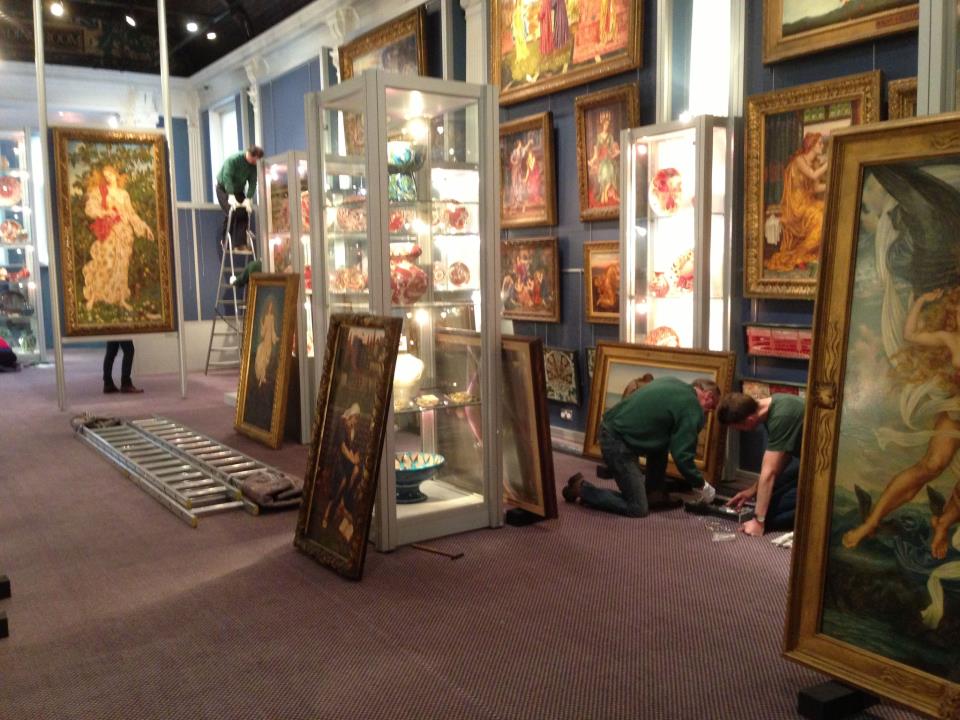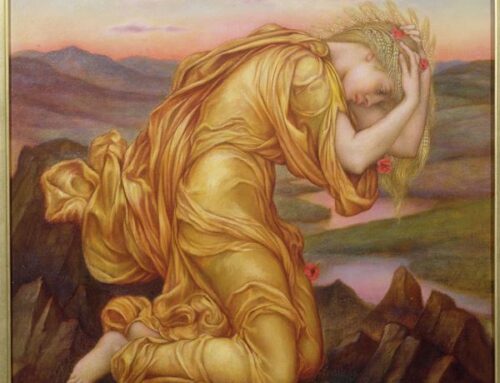Our recent rehang of the gallery
From time to time, repeat visitors to the gallery will wander in, take a long look around and declare, ‘Something is different!’. Those with a keen eye will notice that every so often we move around the ceramics, rearranging them in the cases to give a fresh view, to highlight particular themes in the decoration, or to swap objects around so we can display different ceramics from our stores.
It is rather less often that we reshuffle Evelyn’s paintings. The largest of our canvases on display, Our Lady of Peace, is a staggering 1.9 metres tall, so as you can imagine, moving them around is rather a huge undertaking. It takes the watchful eye of the curator, the careful skill of our painting conservators, several burly picture hangers and the best part of a day to rearrange Evelyn’s stunning artworks. However, there are some very valid reasons that justify us undertaking this task several times a year.
Evelyn’s oil paintings and their often ornate frames are made up of a number of materials, including canvas, wood, glue, paint, varnish and metal. These components are sensitive to their environment and can be affected by changes in heat and humidity and by pollution from the main road that passes in front of the museum. For this reason, it is prudent for us to cycle the works that are on display; sometimes paintings are taken down to be conserved, and often they are just moved to our art store, where the environment is controlled and they are less exposed to the elements. Conservation and preservation of the collection are one of the key aims of the De Morgan Foundation, so taking these steps to keep the artwork in good condition is very important to us.
The Gilded Cage
Often, we need to take down a painting to be exhibited elsewhere. Loans and tours are a fantastic way for the works of the De Morgans to be seen by a wider audience, and you may have seen the ceramics and paintings at the National Trust’s Standen property, or at the recent Watts Gallery exhibition. Frequently, when a loan is returned to us, we are very keen to rehang the painting in the gallery as soon as possible, as was the case when Flora returned from Japan, and this necessitates rearranging the gallery.
The Gilded Cage is a wonderful example of Evelyn exploring issues of women in the domestic sphere, so when it was returned to us from the Watts Gallery last month we were excited to have it on display again, and it is now proudly hanging in the gallery.
Ariadne in Naxos
Sometimes the paintings make a small excursion to our temporary exhibition space, to feature in a curated exhibition. Last year, our exhibition ‘De Morgans and The Sea’ looked at maritime and coastal imagery in our collections, and featured paintings including S.O.S. and Ariadne in Naxos. When the exhibition ended, these paintings needed to find a home, either in our art store or back in the gallery.
We luckily found space to rehang the two aforementioned paintings in the permanent gallery, so if you enjoyed seeing them before, you now have a chance to see them again.

The final reason we like to undertake re-hangings is quite simple: it keeps the gallery fresh! We are able to display the majority of the paintings in our collection, but we just don’t have the space for them all, so every now and then we like to take the opportunity to take down an old favourite for a time and hang something different that visitors may not have seen before. In our most recent rehang just last month, we were able to display Angel of Death, an imposing canvas that has not been displayed for several years. We also found space for Mercury, which is being displayed for the first time ever here at our current location.
If you’re visiting the gallery to see a particular painting, it’s always worth contacting us to find out if it is currently on display. And if you haven’t visited for a while, we heartily encourage you to make another trip, as you’ll probably encounter something new; you might just fall in love with a painting you’ve never seen before!
– Emma Coleman, Museum Officer









